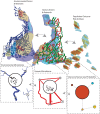Emerging Priorities for Microbiome Research
- PMID: 32140140
- PMCID: PMC7042322
- DOI: 10.3389/fmicb.2020.00136
Emerging Priorities for Microbiome Research
Abstract
Microbiome research has increased dramatically in recent years, driven by advances in technology and significant reductions in the cost of analysis. Such research has unlocked a wealth of data, which has yielded tremendous insight into the nature of the microbial communities, including their interactions and effects, both within a host and in an external environment as part of an ecological community. Understanding the role of microbiota, including their dynamic interactions with their hosts and other microbes, can enable the engineering of new diagnostic techniques and interventional strategies that can be used in a diverse spectrum of fields, spanning from ecology and agriculture to medicine and from forensics to exobiology. From June 19-23 in 2017, the NIH and NSF jointly held an Innovation Lab on Quantitative Approaches to Biomedical Data Science Challenges in our Understanding of the Microbiome. This review is inspired by some of the topics that arose as priority areas from this unique, interactive workshop. The goal of this review is to summarize the Innovation Lab's findings by introducing the reader to emerging challenges, exciting potential, and current directions in microbiome research. The review is broken into five key topic areas: (1) interactions between microbes and the human body, (2) evolution and ecology of microbes, including the role played by the environment and microbe-microbe interactions, (3) analytical and mathematical methods currently used in microbiome research, (4) leveraging knowledge of microbial composition and interactions to develop engineering solutions, and (5) interventional approaches and engineered microbiota that may be enabled by selectively altering microbial composition. As such, this review seeks to arm the reader with a broad understanding of the priorities and challenges in microbiome research today and provide inspiration for future investigation and multi-disciplinary collaboration.
Keywords: gut microbiome; microbial forensics; microbiome ecology; microbiome evolution; microbiome interactions; prebiotics; probiotics; skin microbiome.
Copyright © 2020 Cullen, Aneja, Beyhan, Cho, Woloszynek, Convertino, McCoy, Zhang, Anderson, Alvarez-Ponce, Smirnova, Karstens, Dorrestein, Li, Sen Gupta, Cheung, Powers, Zhao and Rosen.
Figures




References
Publication types
LinkOut - more resources
Full Text Sources
Research Materials
Miscellaneous

